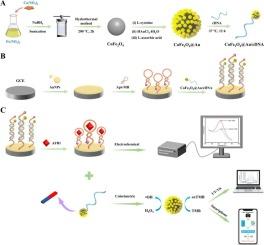An electrochemical/colorimetric dual-mode sensor for the detection of AFB1 in agricultural products based on CoFe2O4@Au nanoparticles and smartphone imaging
IF 9.8
1区 农林科学
Q1 CHEMISTRY, APPLIED
引用次数: 0
Abstract
An electrochemical/colorimetric dual-model sensor was developed for the specific detection of aflatoxin B1, utilizing the high catalytic activity and magnetic separation properties of CoFe2O4@Au along with the conformational alterations in the hairpin DNA structure. The CoFe2O4@Au nanocomposite demonstrated excellent peroxidase-like activity, characterized by the relatively low Michaelis constant (Km = 0.14 mM and 0.94 mM) and the relatively high reaction rate (Vmax = 4.43 × 10−8 M·s−1 and 9.01 × 10−8 M·s−1). Besides, the visualization results could be obtained using a smartphone in colorimetric mode. The detection linear ranges of the electrochemical workstation, ultraviolet-visible spectrophotometer, and smartphone were 0.001–100 ng mL−1, 0.05–100 ng mL−1, and 0.1–100 ng mL−1, respectively, with corresponding limits of detection were 0.34 pg mL−1, 0.016 ng mL−1, and 0.043 ng mL−1. Furthermore, the matrix effect values of these methods were 91.03 %–112.96 % in peanut, corn, and wheat. This work provided a new direction to explore dual-mode sensor to improve the detection accuracy in real samples.


基于CoFe2O4@au纳米粒子和智能手机成像的农产品中AFB1的电化学/比色双模传感器
利用CoFe2O4@Au的高催化活性和磁分离特性以及发夹DNA结构的构象改变,研制了一种用于黄曲霉毒素B1特异性检测的电化学/比色双模传感器。CoFe2O4@Au纳米复合材料展示优秀peroxidase-like活动,以相对较低的米氏常数(0.14公里 = 毫米和0.94毫米)和相对较高的反应速率(Vmax = 4.43 × 10−8 M·s−1和9.01 × 10−8 M·s−1)。此外,可以使用智能手机在比色模式下获得可视化结果。检测线性范围的电化学工作站,紫外-可见分光光度计、和智能手机0.001 -100 ng 毫升−1,0.05 -100 ng 毫升−1和0.1 -100 ng 毫升−1,分别与相应的检测极限是0.34 pg 毫升−1,0.016 ng 毫升−1和0.043 ng 毫升−1。花生、玉米和小麦的基质效应值为91.03 % ~ 112.96 %。本工作为探索双模传感器在实际样品中提高检测精度提供了新的方向。
本文章由计算机程序翻译,如有差异,请以英文原文为准。
求助全文
约1分钟内获得全文
求助全文
来源期刊

Food Chemistry
工程技术-食品科技
CiteScore
16.30
自引率
10.20%
发文量
3130
审稿时长
122 days
期刊介绍:
Food Chemistry publishes original research papers dealing with the advancement of the chemistry and biochemistry of foods or the analytical methods/ approach used. All papers should focus on the novelty of the research carried out.
文献相关原料
公司名称
产品信息
麦克林
Tris(2-carboxyethyl) phosphine hydrochloride (TCEP)
麦克林
5,5-dimethyl-1-pyrroline N-oxide (DMPO)
麦克林
tryptophan (Trp)
麦克林
KH?PO?
麦克林
HAuCl?·4H?O
麦克林
Co(NO?)?·6H?O
麦克林
NaBH?
麦克林
Fe(NO?)?·9H?O
阿拉丁
patulin (PAT)
阿拉丁
isopropanol (IPA)
阿拉丁
superoxide dismutase (SOD)
阿拉丁
o-phenylenediamine (OPD)
阿拉丁
zearalenone (ZEN)
阿拉丁
L-cysteine
阿拉丁
ochratoxin (OTA)
阿拉丁
l-ascorbic acid
阿拉丁
bovine serum albumin (BSA)
阿拉丁
aflatoxin B1
 求助内容:
求助内容: 应助结果提醒方式:
应助结果提醒方式:


